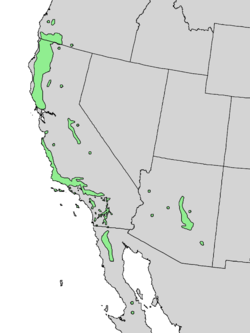| Mountain mahogany | |
|---|---|
 | |
| var. blancheae in fruit | |
| Scientific classification | |
| Kingdom: | Plantae |
| Clade: | Tracheophytes |
| Clade: | Angiosperms |
| Clade: | Eudicots |
| Clade: | Rosids |
| Order: | Rosales |
| Family: | Rosaceae |
| Genus: | Cercocarpus |
| Species: | C. betuloides |
| Binomial name | |
| Cercocarpus betuloides Nutt. 1840 | |
 | |
| Natural range of Cercocarpus betuloides | |
| Synonyms [1] | |
Cercocarpus montanus var. glaber (S. Watson) F.L. Martin Contents | |
Cercocarpus betuloides is a shrub or small tree in the rose family. [2] Its common names include mountain mahogany and birch leaf mountain mahogany [2] [3] The common name "mahogany" comes from the hardness and color of the wood, although the genus is not a true mahogany. [2]